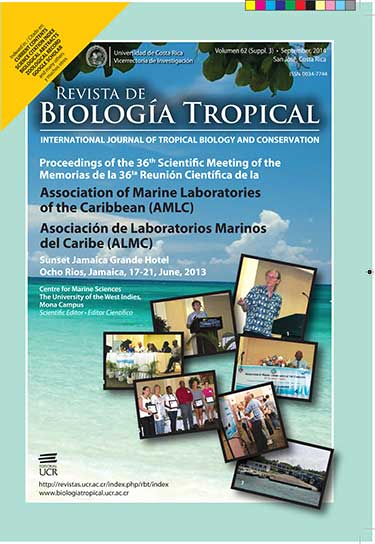Abstract
Jamaica’s trans-shipment industry is amongst the largest in the Caribbean with 90% of trans-shipment activities occurring in Kingston Harbour. The eastern ship channel is populated with patch and fringing coral reefs. In 2002, approximately 20% of an originally sloping face of Rackham’s Cay, on the southern edge of the channel, was cut vertically to 18m and dredged to widen the channel. The successional changes on the newly created vertical limestone wall was assessed between 2009 and 2012 at 5m, 10m and 15m depths using bi-annual photographs of fixed 1 m2 quadrats. Photographs were analyzed using Coral Point Count. No colonization of either algal or coralline species was observed at 15m. Initially calcareous and fleshy algae dominated at 5m but showed a gradual decrease over time. Calcareous algae dominated at 10m and increaseed gradually over the 4 years. Stony corals at both 5m and 10m had overall low cover and slow colonization; the shallower depth had more coverage (4.1% maximum in 2011). Siderastrea sidera -which dominated Rackham’s Cay before dredging- was consistently present in low coverage. Colonization by species of Acropora and Scolymia indicate slower but better succession at 10m. Ten years following dredging activities, colonization and recruitment have been slow but successful at 5m and 10m; species previously described as abundant lead the colonization. We recommend limiting coral relocation activities to depths not exceeding 10m. Rev. Biol. Trop. 62 (Suppl. 3): 107-114. Epub 2014 September 01.References
Centre for Marine Sciences, UWI. (2005). Report on Monitoring of Transplanted Corals at Rackhams Cay, Kingston Harbour, Jamaica. Wisconsin: UWI.
Gayle, P. M. H., Wilson-Kelly, P., & Green, S. (2005). Transplantation of benthic species to mitigate impacts of coastal development in Jamaica. Revista de Biología Tropical, 53, 105-115.
Grigg, R. W., & Maragos, J.E. (1974). Recolonization of hermatypic coral on submerged lava flows in Hawaii. Ecology, 55(2), 387-395.
Humman, P., & DeLoach, E. (2003). Reef coral Identification: Florida, Caribbean, Bahamas. Florida: New World Publications Inc.
Huston, M. A. (1994). Biological Diversity; The coexistence of species on changing landscapes. New York: Cambridge University Press.
Huston, M. A., & Smith, T.M. (1987). Plant succession: Life History and competition. American Naturalist, 130, 168-198.
Jaap, W.C. (2000). Coral reef restoration. Ecological Engineering, 15, 345-364
Jaap, W. C., Hudson, J. H., Dodge, R. E., & Gillian, D. (2006). Coral reef restoration with case studies from Florida. Conservation, 137, 52-162
McNaught, M. A. (2007). The status of the coral reefs within the Palisadoes-Port Royal protected Area: Detecting hurricane impacts between 2001 and 2005 using the regional monitoring protocol. MSc Thesis of the Department of Life Sciences, University of the West Indies, Mona, Jamaica.
Mendes, J. M. (1992). A description of the fringing reefs of Lime Cay, Port royal Cays, Jamaica with long term monitoring. MSc Thesis of the Department of Life Sciences, University of the West Indies, Mona, Jamaica.
Miller, M. W. (1996). The coral reefs of the Port Royal Cays Jamaica: Drunkenman’s Cay, Gun Cay, Maiden and East Middle Ground Shoal. MSc Thesis of the Department of Life Sciences, University of the West Indies, Mona, Jamaica.
NEPA. (2012). Coral Reefs of Jamaica, An Evaluation of Ecosystems Health: 2011. NEPA.
Ohba, M., Shibuno, T., Takada, Y., Suzuki, A., Nagao, M., Tottori, K., ... & Fujioka, Y. (2006). Subtropical marine vegetation under the influence of rivers at Miyara Bay in Ishigaki Island, Ryukyus (southern Japan). In Proc 10th Int Coral Reef Symp (Vol. 1, pp. 319-326).
Sokal, R. R., & Rohlf, F.J. (1981). Biometry. 2nd edition. San Francisco, Ca: Freeman.
Tomascik, T., Van Woesik, R., & Mah, A. J. (1996). Rapid coral colonization of a recent lava flow following a volcanic eruption, Banda Islands, Indonesia.Coral Reefs, 15(3), 169-175.
Vermeij, M. J. A. (2006). Early life-history dynamics of Caribbean coral species on artificial
substratum: the importance of competition, growth and variation in life-history strategy. Coral Reefs, 25, 59–71 DOI 10.1007/s00338-005-0056-7
Walker, L. R., & del Moral, R. (2003). Primary Succession and Ecosystem Rehabilitation New York: Cambridge University Press.
Wilkinson, C., & Souter, D. (2008). Status of Caribbean coral reefs after bleaching and hurricanes in 2005. Global Coral Reef Monitoring Network, and Reef and Rainforest Research Centre, Townsville, Australia.
##plugins.facebook.comentarios##

This work is licensed under a Creative Commons Attribution 4.0 International License.
Copyright (c) 2014 Revista de Biología Tropical






